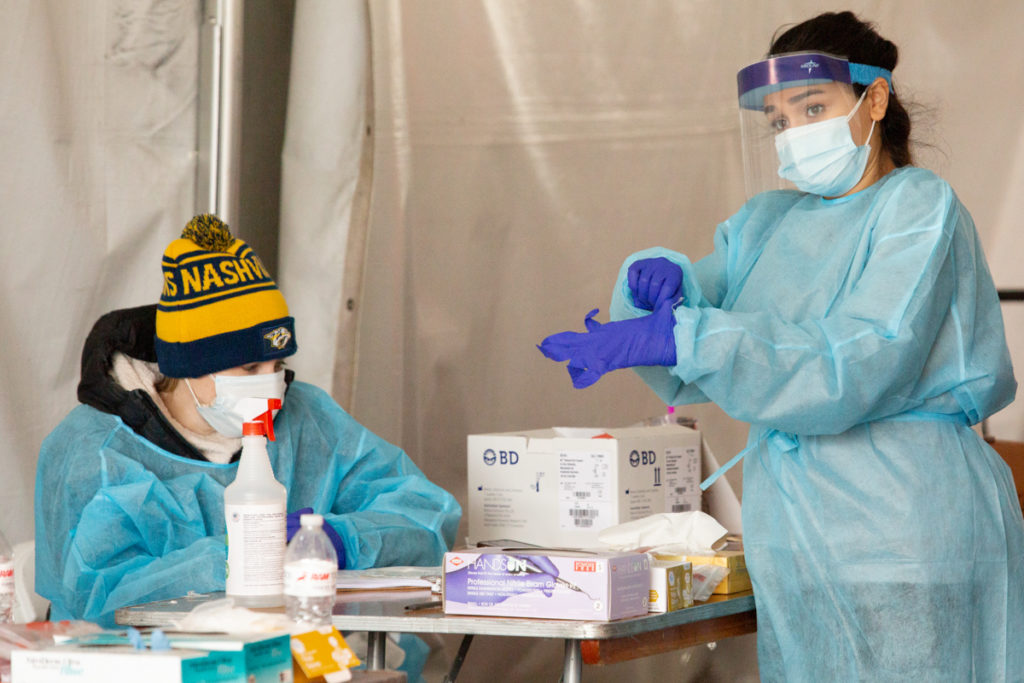
This day in 2020 is when the World Health Organization made it official: COVID-19 had become a pandemic.
In just 12 months, so much has happened it’s hard to remember what those earliest days were like. So here’s a look at the start of the pandemic in Tennessee.
The opening scene begins in the Williamson County Emergency Management offices. Dozens of reporters, local officials and public health experts packed into a small media room, shoulder to shoulder — no one wearing a mask. Officials explained how they would respond to the state’s first confirmed case, linked to a now-infamous BioGen conference that became a super-spreader event. Williamson County Schools called off classes for the week as a precaution, despite the patient not having kids in public schools. And the cancellations just dominoed from there.
More: Read WPLN News’ initial live blog from early March 2020
It took a few weeks of pressure from medical professionals for Tennessee’s governor to issue a stay-at-home order and close non-essential businesses. That was the end of March. By that point, Tennessee had only about 1,200 cases in total. Now, a year later, the state often sees more than 1,200 new cases a day — and that’s an improvement over 11,000 from mid-December.
But last March, Tennesseans were already seeing predictions of what could happen and how thousands could die. And that might have seemed hard for many to believe because most people didn’t know many people who’d been sick.
Still, there was a rush on everything — toilet paper, cleaning supplies, and masks. Physicians were even asking their neighbors for masks because there were none to buy.
More: See how the pandemic hit Tennessee over the winter, in charts
That shortage of masks — along with gloves, face shields, what we’ve now come to know as “PPE” — was the big reason hospitals were told to shut down elective procedures. It was about conserving simple protective gear that you can now find just about everywhere.
They were also concerned about ventilators and prioritizing them for COVID patients instead of knee replacements. The state even purchased more to stockpile. But in reality, hospitals were not a very busy place. Many had to furlough nurses.
Other than a few places like Sumner Regional Medical Center, which was handling a huge outbreak at a nursing home in Gallatin, hospitals were seeing far fewer patients than normal. But they were still preparing in ways that were shocking at the time. Vanderbilt University Medical Center quietly built a COVID assessment center in their parking garage. State officials scouted sites like the Music City Center for field hospitals. They thought what happened in New York and New Jersey — where hospitals were overrun — would happen in Tennessee.
But it didn’t.
More: Gov. Lee Says Safer At Home Order Will Expire, Plans To Reopen Economy, April 20, 2020
The cases didn’t pick up. And the state’s stay-at-home order expired at the end of April. Many believed Tennessee had beaten the pandemic.
Infectious disease experts were certainly warning that was likely not the end. But it was hard to make a case to the public, especially in the South, because the region had generally dodged the worst of it. Until July rolled around. Cases took off like never before in late summer.
There was a bit of a lull ahead of Election Day, and then the full fury of COVID struck after Thanksgiving. That was when Tennessee was leading the nation — and by some measures, the world — in new cases. It was a scary time, when hospitals were under such strain they were looking for anywhere to add a bed or squeeze an extra patient.
More: Nearly Half Of Cities With Fastest Growing Coronavirus Cases Are In Tennessee, Dec. 15, 2020
But that hit just as the life-saving vaccine came out. And everything changed.
Now, the long winter is ending. So is this the end?
Numbers have dropped so quickly that some epidemiologists aren’t sure quite what’s happening. But what’s known is that the vaccines are incredibly effective, and places where most people have had them, like nursing homes, have seen new illnesses drop by more than 80%.
It’s certainly not the very end, as variants present a big question mark, but there could be a smoother ride to the finale.

